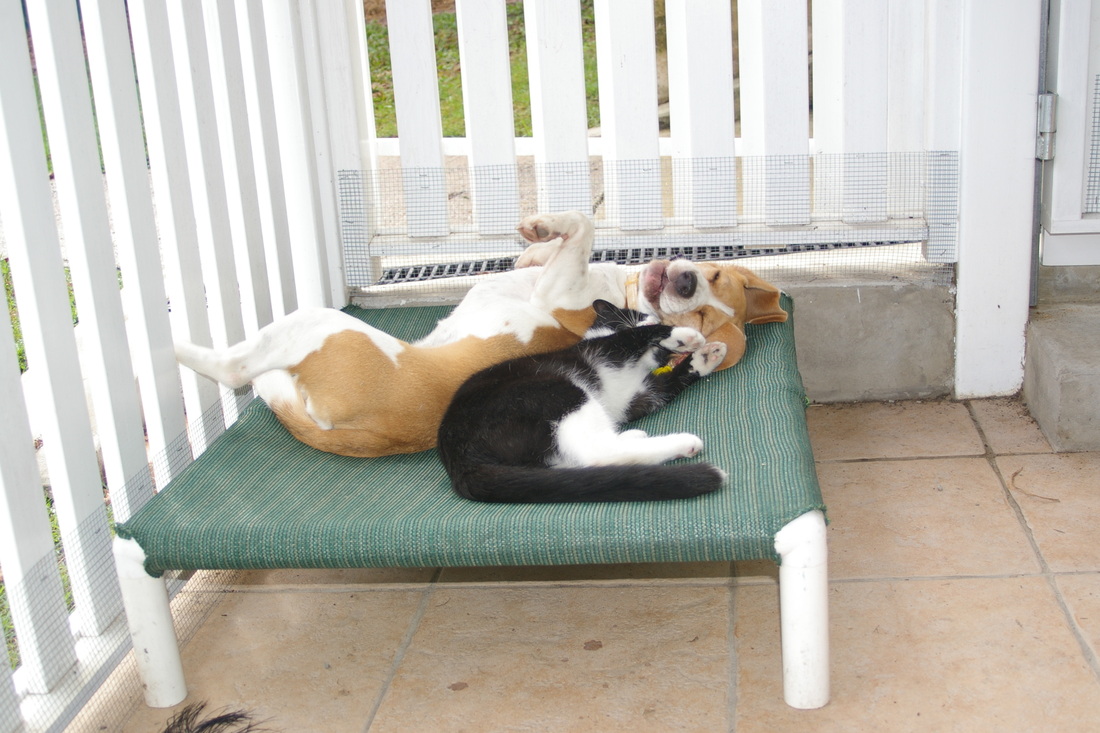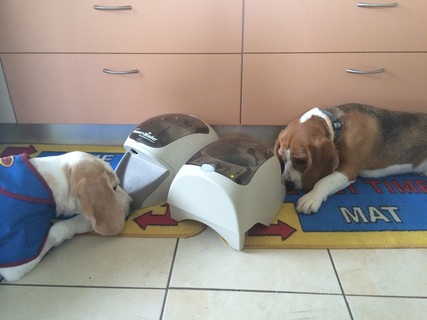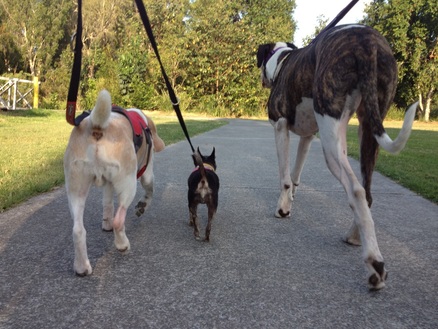Dominance is needed in Dog Training
Why you shouldn't believe this myth
Ok, so do you know a dog that seems a little pushy? Does he jump on you, rush through doorways, bark at you, pull on lead or mouth you? Chances are, if this is the case, and you have watched a little TV or talked to your mechanic at the dog park, you have been told that your dog is dominating you.
Well the truth is... ... wait for it... ... as much as we all know your dog is smart, he is not actually trying to take over you or the world.
Let’s have a look at the definition of dominance.
Dominance is defined as a relationship between two or more individuals that is established by force, aggression, and submission in order to gain priority access to resources (Bernstein 1981; Drews 1993)
In the dog world, this resource, is more often than not, a tasty piece of food, prized toy or valued family member. It can also be anything the dog finds valuable, so in some cases it may be your sock, in others perhaps a doorway (means of escape), a comfy bed or even attention.
Different resources motivate different dogs at different times. This means the relationship can change – just like you might argue with your partner about which movie to see or restaurant to eat at, but at other times be quite happy to let them have their choice.
Examples of things my dogs find valuable – Poco finds human family members valuable. Arthur finds food valuable. Koffi finds tennis balls (in particular the squeaky kong version) valuable. Each dog may have multiple things they find valuable, others may have just one.
Dominance is not a personality trait. Dominance is "primarily a descriptive term for relationships between pairs of individuals." and moreover, "the use of the expression 'dominant dog' is meaningless, since "dominance" can apply only to a relationship between individuals. (Bradshaw et al., 2009)
Many will tell you that dominance relates to the Alpha wolf and that one (usually male) wolf must have control of everything within its pack. This is false. David Mech has studied wolves for many years, and did originally make the previous conclusion. However, this was related to an unrelated pack of wolves, in artificial circumstances. Since then, David has studied wolves in their natural environment, and contrary to popular belief has found that they live in social structures much like our own families, with very little reliance on aggression.
Also, you should consider, that although dogs and wolves are related, there are some distinct differences – both behavioural and physical. Examples include that dogs play throughout their lives – wolves don’t. Dogs are usually friendly to unfamiliar dogs and other species (cats/humans etc). Wolves aren’t.
Dogs can read human body language and follow gestures and gazes – better than both wolves and chimpanzees.
Well the truth is... ... wait for it... ... as much as we all know your dog is smart, he is not actually trying to take over you or the world.
Let’s have a look at the definition of dominance.
Dominance is defined as a relationship between two or more individuals that is established by force, aggression, and submission in order to gain priority access to resources (Bernstein 1981; Drews 1993)
In the dog world, this resource, is more often than not, a tasty piece of food, prized toy or valued family member. It can also be anything the dog finds valuable, so in some cases it may be your sock, in others perhaps a doorway (means of escape), a comfy bed or even attention.
Different resources motivate different dogs at different times. This means the relationship can change – just like you might argue with your partner about which movie to see or restaurant to eat at, but at other times be quite happy to let them have their choice.
Examples of things my dogs find valuable – Poco finds human family members valuable. Arthur finds food valuable. Koffi finds tennis balls (in particular the squeaky kong version) valuable. Each dog may have multiple things they find valuable, others may have just one.
Dominance is not a personality trait. Dominance is "primarily a descriptive term for relationships between pairs of individuals." and moreover, "the use of the expression 'dominant dog' is meaningless, since "dominance" can apply only to a relationship between individuals. (Bradshaw et al., 2009)
Many will tell you that dominance relates to the Alpha wolf and that one (usually male) wolf must have control of everything within its pack. This is false. David Mech has studied wolves for many years, and did originally make the previous conclusion. However, this was related to an unrelated pack of wolves, in artificial circumstances. Since then, David has studied wolves in their natural environment, and contrary to popular belief has found that they live in social structures much like our own families, with very little reliance on aggression.
Also, you should consider, that although dogs and wolves are related, there are some distinct differences – both behavioural and physical. Examples include that dogs play throughout their lives – wolves don’t. Dogs are usually friendly to unfamiliar dogs and other species (cats/humans etc). Wolves aren’t.
Dogs can read human body language and follow gestures and gazes – better than both wolves and chimpanzees.
Dogs surprised cognition researchers when scientists showed that the animals readily follow a human’s pointing finger or gaze to find food. Both wolves, dogs’ closest relative, and chimpanzees, our near-cousin, have trouble doing this. (Rossana, Nitzschner and Tomasello, 2014)
So we should not base how dogs live on how wolves live. This is no more relevant than basing how we live, compared with how chimpanzees live.
Most undesirable behaviors in our pets are not related to priority access to resources; rather, they are due to accidental rewarding of the undesirable behavior.
Some Examples:
So we should not base how dogs live on how wolves live. This is no more relevant than basing how we live, compared with how chimpanzees live.
Most undesirable behaviors in our pets are not related to priority access to resources; rather, they are due to accidental rewarding of the undesirable behavior.
Some Examples:
Your dog counter surfs and steals from the kitchen bench…
Why:
Dogs are natural scavengers. No self-respecting dog will leave food given the choice. Bored dogs, look for something to do and entertain themselves. Any time a dog is successful in counter surfing, he is rewarded, and the behaviour is more likely to occur again.
What you can do:
Don’t leave food out that your dog can reach.
Teach your dog a more desirable behaviour, and reward this. I use mats, and train my dogs to stay on the mat when I am in the kitchen. When on their mat, they are likely to get a treat tossed their way as I cut up the carrots, chicken etc.
Get your dog working for his food using enrichment toys, kongs, scatter feeds and training. See the Canine Enrichment page for more ideas.
Why:
Dogs are natural scavengers. No self-respecting dog will leave food given the choice. Bored dogs, look for something to do and entertain themselves. Any time a dog is successful in counter surfing, he is rewarded, and the behaviour is more likely to occur again.
What you can do:
Don’t leave food out that your dog can reach.
Teach your dog a more desirable behaviour, and reward this. I use mats, and train my dogs to stay on the mat when I am in the kitchen. When on their mat, they are likely to get a treat tossed their way as I cut up the carrots, chicken etc.
Get your dog working for his food using enrichment toys, kongs, scatter feeds and training. See the Canine Enrichment page for more ideas.
|
Barking for attention:
Why: Dogs bark for many reasons, and you should carefully review the barking location, frequency etc to decide why its occurring and when. However if your dog is barking at you, it may be for attention. Attention to a dog is ANY attention, and they are therefore rewarded when you look at them, touch them, tell them NO STOP BARKING, or feed them. What you can do: Give your dog a different job. If your dog barks at you when you prepare dinner, give him a kong (before the barking starts) or other food dispensing toy to keep him busy. Do mat training, and reward him for quiet. Invest in a Manners Minder and train your dog at distance with a remote control food dispensing unit. Your dog jumps on you Why: Dogs jump on people, usually as a greeting behaviour. They are usually rewarded for this, if not by you, but by other walkers when out in the street, family members etc. A reward is petting, looking, or any interaction with the dog. What you can do: Teach your dog a reliable sit, and ask for this behaviour before you enter the house, or before visitors come in. Have your dog on lead, so that you have control. As soon as your dog jumps, remove your attention (cross your arms and look away), and reward again as soon as all 4 paws are on the floor. |
|
Your dog pulls on leash
Why: Unless you have taught your dog what a loose leash is, your dog has no idea what you would rather him do. They are not pulling to frustrate you, they are pulling because they don’t know any better, and as far as they are concerned, pulling works. If I pull towards the tree, I get to sniff the tree. Guess what just happened? Your dog got rewarded. What you can do: Teach a reliable loose leash walk. Start in an environment of low distraction (the house, not the dog park). Any time your dog pulls on lead, stop walking forward and hold your ground. Call your dog back to you, reward them when they are near you and continue walking. If your dog has been a leash puller for some time, stop judging your walks on distance, instead judge them on time. Initially you may only get to the end of the driveway in a 30 minute session, but consistency is the key. |
Humping
Why:
Dogs can hump for a few reasons. Often it is attention seeking, anxiety or play based.
What you can do:
Again, avoid giving your dog attention for this behaviour. However, if you can predict when this is going to occur, ask your dog to do something else instead. A sit or drop are good ideas.
Dog rushes past you and out the door
Why:
Whatever is outside is more exciting then you and you just happen to be in the way.
What you can do:
Teach your dog a reliable “wait” behaviour. Ask for a sit, and move your hand to the door. If your dog stands up, remove your hand and ask for the sit again. Repeat, until you can slowly move the handle, then the door etc, without the dog barreling past you.
If in doubt, install a baby gate so that you can open the door and not have the dog rush out.
Okay, so hopefully the information above has helped clear up some of the “dominance” misconceptions.
With clear, consistent training, your dog will be a valued, well-mannered and polite family member.
If you have any concerns, please contact a good, positive reinforcement based dog trainer.
References:
Apdt.com, (2015). Dominance and Dog Training. [online] Available at: https://apdt.com/pet-owners/choosing-a-trainer/dominance/ [Accessed 8 Feb. 2015].
ASPCA, (2015). Dog Parks. [online] Available at: https://www.aspca.org/pet-care/virtual-pet-behaviorist/dog-behavior/dog-parks [Accessed 6 Feb. 2015].
Ava.com.au, (2013). Debunking dominance in dogs | Australian Veterinary Association. [online] Available at: http://www.ava.com.au/public/about-pets/polite-pets-month/resources/debunking-dominance-dogs [Accessed 8 Feb. 2015].
Bernstein, I.S. 1981. Dominance: The baby and the bathwater. J Behav Brain Sci 4:419-57.
Blake, M. (2008). The dog trainers resource 2. Wenatchee, Wash.: Dogwise Pub.
Bradshaw J.W.S., Blackwell E.J., Casey R.A. 2009. Dominance in domestic dogs - useful construct or bad habit? Journal of Veterinary Behavior: Clinical Applications and Research, May/June 2009, pp 135-144.
Drews, C. 1993. The concept and definition of dominance behavior. Behaviour 125: 284-313.
Rossano, F., Nitzschner, M. and Tomasello, M. (2014). Domestic dogs and puppies can use human voice direction referentially. Proceedings of the Royal Society B: Biological Sciences, 281(1785), pp.20133201-20133201.
Teglas, E. (2012). In the Eyes of a Dog. [online] News.sciencemag.org. Available at: http://news.sciencemag.org/2012/01/eyes-dog [Accessed 8 Feb. 2015].
Yin, S. (2009). Low stress handling, restraint and behavior modification of dogs & cats. Davis, CA: CattleDog Pub.
Yin S. 2009. Dominance vs. unruly behavior. The APDT Chronicle of the Dog, Mar/Apr 2009, pp. 13-17.
Yin, S., n.d. How to behave so your dog behaves. 1st ed. Neptune City, NJ: T.F.H. Publications, c2010.
Why:
Dogs can hump for a few reasons. Often it is attention seeking, anxiety or play based.
What you can do:
Again, avoid giving your dog attention for this behaviour. However, if you can predict when this is going to occur, ask your dog to do something else instead. A sit or drop are good ideas.
Dog rushes past you and out the door
Why:
Whatever is outside is more exciting then you and you just happen to be in the way.
What you can do:
Teach your dog a reliable “wait” behaviour. Ask for a sit, and move your hand to the door. If your dog stands up, remove your hand and ask for the sit again. Repeat, until you can slowly move the handle, then the door etc, without the dog barreling past you.
If in doubt, install a baby gate so that you can open the door and not have the dog rush out.
Okay, so hopefully the information above has helped clear up some of the “dominance” misconceptions.
With clear, consistent training, your dog will be a valued, well-mannered and polite family member.
If you have any concerns, please contact a good, positive reinforcement based dog trainer.
References:
Apdt.com, (2015). Dominance and Dog Training. [online] Available at: https://apdt.com/pet-owners/choosing-a-trainer/dominance/ [Accessed 8 Feb. 2015].
ASPCA, (2015). Dog Parks. [online] Available at: https://www.aspca.org/pet-care/virtual-pet-behaviorist/dog-behavior/dog-parks [Accessed 6 Feb. 2015].
Ava.com.au, (2013). Debunking dominance in dogs | Australian Veterinary Association. [online] Available at: http://www.ava.com.au/public/about-pets/polite-pets-month/resources/debunking-dominance-dogs [Accessed 8 Feb. 2015].
Bernstein, I.S. 1981. Dominance: The baby and the bathwater. J Behav Brain Sci 4:419-57.
Blake, M. (2008). The dog trainers resource 2. Wenatchee, Wash.: Dogwise Pub.
Bradshaw J.W.S., Blackwell E.J., Casey R.A. 2009. Dominance in domestic dogs - useful construct or bad habit? Journal of Veterinary Behavior: Clinical Applications and Research, May/June 2009, pp 135-144.
Drews, C. 1993. The concept and definition of dominance behavior. Behaviour 125: 284-313.
Rossano, F., Nitzschner, M. and Tomasello, M. (2014). Domestic dogs and puppies can use human voice direction referentially. Proceedings of the Royal Society B: Biological Sciences, 281(1785), pp.20133201-20133201.
Teglas, E. (2012). In the Eyes of a Dog. [online] News.sciencemag.org. Available at: http://news.sciencemag.org/2012/01/eyes-dog [Accessed 8 Feb. 2015].
Yin, S. (2009). Low stress handling, restraint and behavior modification of dogs & cats. Davis, CA: CattleDog Pub.
Yin S. 2009. Dominance vs. unruly behavior. The APDT Chronicle of the Dog, Mar/Apr 2009, pp. 13-17.
Yin, S., n.d. How to behave so your dog behaves. 1st ed. Neptune City, NJ: T.F.H. Publications, c2010.



